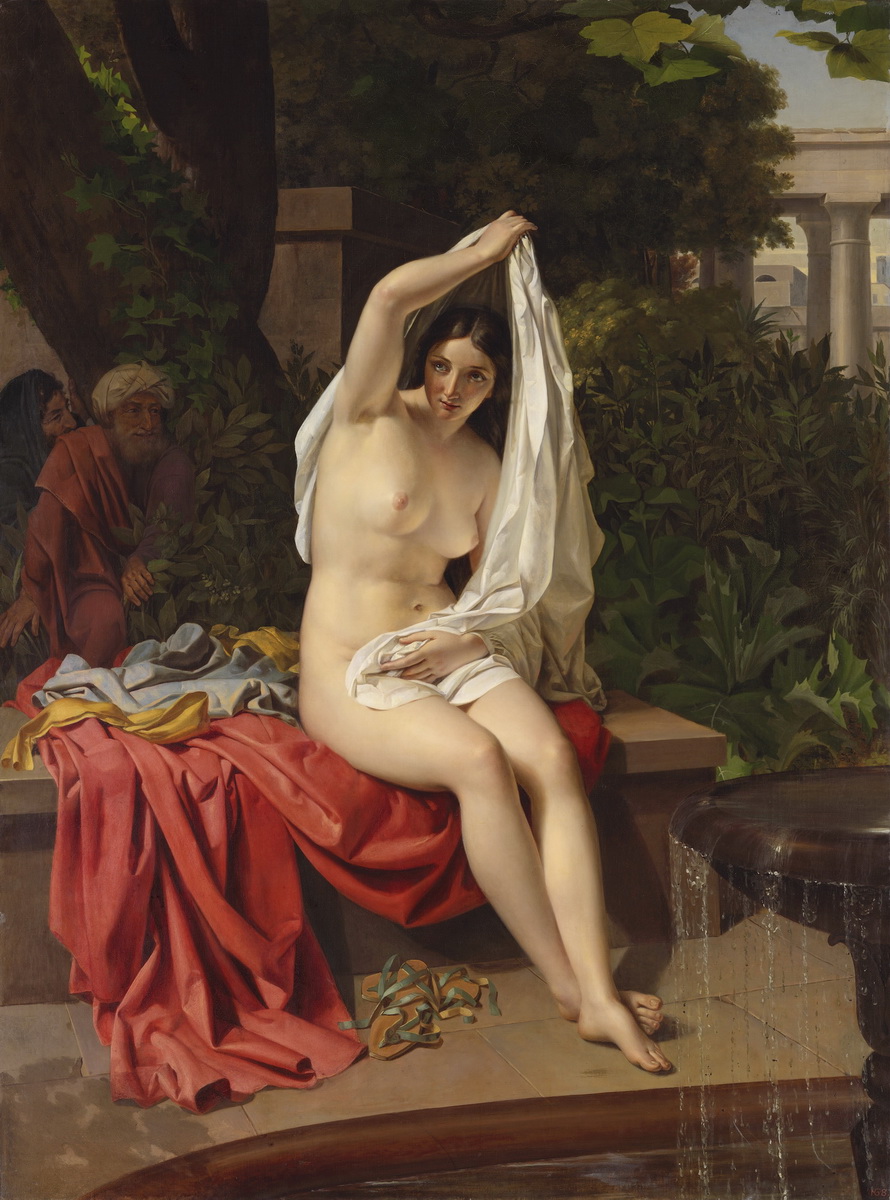


Картина «Сусанна и старцы» — вершина творчества Григория Игнатьевича Лапченко. На ней изображена Суса́нна — еврейка из Вавилона, за которой, согласно Ветхому завету, подглядывали в саду два старца во время её прогулки, а затем, угрожая обвинить её в прелюбодеянии с незнакомцем, пытались добиться взаимности. За непослушание она была обвинена и приговорена к смерти. Но, благодаря пророку Даниилу, была спасена, а лжесвидетели уличены во лжи и казнены.
Моделью для Сусанны для художника послужила итальянская красавица, дочь бедного винодела из Альбано - Виттория Кальдони, которая стала впоследствии и его женой. Она же позировала и А. А. Иванову.
В письме художника в Правление ИАХ из Рима, датированном 23 ноября 1831, сказано: «Я на месте моего пребывания написал картину, представляющую раздевающуюся Сусанну естественной величины...». После возвращения из Италии художник подал прошение удостоить его по написанной картине звания академика. Совет ИАХ определил «художника Лапченко удостоить звания академика и представить к утверждению общему собранию Академии; картину же его, изображающую Сусанну, внести в список вещей Академическому Музею».

In the artist’s letter to the Council of the Academy from Rome, dated November 23, 1831, he says: "At the place of my stay I have made a painting representing undressing Susanna in natural size...". After his return from Italy, the artist presented a petition to honour him with the title of academician for the painting performed. The Council decided "to honour the artist Lapchenko with a title of academician and submit for approval to the general meeting of the Academy; his painting, depicting Susanna, to be added to a list of belongings of the Academic Museum". The model V. Caldoni posed for the painting.
Vittoria Caldoni (in Russia – Victoria Antonova Lepchenko) – daughter of a winemaker from Albano, Antonio Caldoni. The last information about her appears in the application filled by G.I. Lepchenko in 1869, where he reports that since 1839 he was married to Victoria, daughter of Antonio Caldoni, as well as in the police permission from 1868 for Gregory Lapchenko to move with his wife Victoria Antonovna to Dinabur, on the back of which there is a mark of the registration in Dinaburg, Vilnius and Saint Petersburg dated 1869, 1870 and 1871.
Artist. Author of historical compositions, portraits. The son of a Cossack Ignaty Vasilyevich Lapa. Studied in Korsun under the artist S.V. Perevolotsky, then in the White Church under the artist Y.Y. Nikitin. From 1822 to 1829 studied at the Academy of Arts as a foreign student under the tutelage of A. I. Ivanov, lived in dependence on the count M.S. Vorontsov and under the patronage of the Society for Encouragement of Artists. In 1826 he received the second silver medal for drawings from life. In 1829 presented to the Council of Academy the painting "Featuring the Kiev Citizen, Who Told Pretich the News about the Pechenegs Sieging Kiev" (Tretyakov Gallery). The Council decided to award the author with the first gold medal at the expense of the Society for Encouragement of Artists. In 1830, together with A. A. Ivanov went to Rome as a scholar of M.S. Vorontsov, executed copies of works by Italian artists. In 1834 almost lost his sight. In 1839 he exhibited in Rome the painting "Featuring a Woman Carrying a Basket on Her Head with an Unfinished Left Arm" acquired by the crown prince Alexander Nikolaevich. In the same year married the model Vittoria Caldoni, with whom he returned home. Lived in Kiev, since the middle of the 1840s in the village Moshny of Kiev province. In 1842 for the painting "Susanna Caught by the Elders" received the title of academician. In 1850 moved to Cherkassy, in 1866 – to the town of Mozyr, Minsk province. In 1869 he moved to live with his son in the town Dinaburg of Vyatka province. In 1872 (1871?) in connection with the transfer of his son moved to St. Petersburg.



